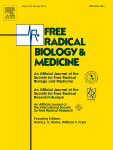Citation:
Ginsburg I, Gibbs DF, Schuger L, Johnson KJ, Ryan US, Ward PA, Varani J. Vascular endothelial cell killing by combinations of membrane-active agents and hydrogen peroxide. Free Radical Biology and Medicine. 1989;7 (4) :369-376.

Abstract:
Previous studies have demonstrated that a number of membrane-active agents are capable of binding to the surface of polymorphonuclear leukocytes (PMN) resulting in an augmentation of superoxide anion and hydrogen peroxide (H2O2) production in response to soluble stimuli. It is now demonstrated that these same membrane-active agents can bind to the surface of endothelial cells and enhance their susceptibility to killing by H2O2. Membrane-active agents which are capable of synergizing with H2O2 include cationic proteins, cationic poly-amino acids, lysophosphatides and enzymes which are capable of degrading membrane phospholipids (e.g., phospholipase C, phospholipase A2 and streptolysin S). In each case, treatment of the target cells with the membrane-active agent and H2O2 produces greater damage than the sum of the damage produced by either agent separately. Since inflammatory lesions, particularly sites of bacterial infection, may contain a rich mixture of cationic substances, phospholipases and phospholipid breakdown products, these substances may contribute to the tissue damage observed at sites of inflammation by enhancing endothelial cell sensitivity to PMN-generated H2O2 as well as by augmenting the generation of H2O2 by PMNs.Publication Global ID: http://www.ncbi.nlm.nih.gov/pubmed?cmd=retrieve&list_uids=2558061&dopt=citation

